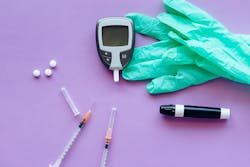WHO report highlights the alarming lack of global access to insulin and diabetes care
A new report published by WHO in the lead-up to World Diabetes Day highlights the alarming state of global access to insulin and diabetes care, and finds that high prices, low availability of human insulin, few producers dominating the insulin market and weak health systems are the main barriers to universal access.
Insulin is the bedrock of diabetes treatment – it turns a deadly disease into a manageable one for nine million people with type 1[i] diabetes. For more than 60 million people living with type 2 diabetes, insulin is essential in reducing the risk of kidney failure, blindness and limb amputation.
However, one out of every two people needing insulin for type 2 diabetes does not get it, according to a WHO press release. Diabetes is on the rise in low- and middle-income countries, and yet their consumption of insulin has not kept up with the growing disease burden. The report highlights that while three in four people affected by type 2 diabetes live in countries outside of North America and Europe, they account for less than 40% of the revenue from insulin sales.
Keeping the 100-year-old promise – making insulin access universal, spotlights the main causes for the gaps in global access to insulin as:
- The global market shift from human insulin, which can be produced at relatively low cost, to the pricier analogues (synthetic insulins) is imposing an untenable financial burden on lower-income countries. In general, human insulin is as effective as analogues, but analogues are at least 1.5 times more expensive than human insulins, and in some countries three times more expensive;
- Three multinational companies control more than 90% of the insulin market, leaving little space for smaller companies to compete for insulin sales;
- Suboptimal regulation and policies, including suboptimal pharmaceutical pricing approaches, weak procurement and supply chain management, insufficient financing to cover demand, and overall weak governance are affecting access to insulin and related devices, such as monitoring and delivery devices, in all countries;
- Insufficient health system capacity and infrastructure, including a lack of service integration at the primary care level, inadequate capacity for providing diabetes care and ensuring supply continuity and infrastructure for information management, supply management, and local production of insulins are widespread challenges in lower-income countries;
- Research is geared towards wealthy markets, neglecting the public health needs of low- and middle-income countries, which account for 80% of the diabetes burden.
The pricing landscape is also uneven and reveals a lack of transparency in the way prices are set, according to the report. For example, biosimilar insulins (essentially generic versions) could be more than 25% cheaper than the originator product, but many countries, including lower-income ones, are
WHO has accelerated efforts to address some of the barriers to the availability of insulin and related medicines and health technologies through a series of dialogues with business associations and manufacturers of these products.
